Numerical Analysis and Experimental Study of the Mechanical Response of Pavement Slab Supported on an Inhomogeneous Settlement
Abstract
:1. Introduction
2. Numerical and Analysis Methods
2.1. Flexural Tensile Stress Calculation of Pavement Slab
2.2. Model Parameters of the Pavement and Foundation
2.3. Type and Position of Aircraft Wheel Load
2.4. Inhomogeneous Distribution of Horizontal Subgrade
3. Effect of Inhomogeneous Subgrade Support
3.1. Flexural Tensile Stress of Pavement Slab
3.2. Vertical Displacement of Pavement Slab
3.3. Stiffness Degradation of Pavement Slab
4. Pavement Scale Model Test
4.1. Stiffness Degradation of Pavement Slab
4.2. Analysis Results of the Model Test
- (1)
- Effect of β on the pavement slab strain
- (2)
- Effect of slab thickness on strain
5. Conclusions
- (1)
- When inhomogeneous subgrade support is used instead of uniform subgrade support, the flexural tensile stress and vertical displacement of the pavement structure increase. For B737-800 aircraft, when the slab thickness is 0.38 m and the change rate of inhomogeneous subgrade support increases from 0% to 85.71%, the flexural tensile stress of the pavement slab increases by 1.60 MPa, and the flexural tensile stress can increase as much as 34%.
- (2)
- The flexural tensile stress of the pavement slab increases with inhomogeneous subgrade support. For A320 aircraft, when the thickness of the pavement is 0.36 m and the change rate of inhomogeneous subgrade support increases from 14.29% to 85.7%, the flexural tensile stress of the pavement increases from 4.51 MPa to 6.93 MPa, and the flexural tensile stress of the pavement is increased by 34.9%.
- (3)
- By increasing the thickness of the pavement slab, the range of the change rate of inhomogeneous subgrade support can be effectively improved. For A320 aircraft, as the thickness of the pavement slab increases from 0.36 m to 0.4 m, the inhomogeneous degree limit of the top support can be increased from 38% to 70%.
- (4)
- To ensure the safety of the pavement slab structure, when the thickness of the pavement slab under the action of the A320 aircraft is 0.36 m, 0.38 m, or 0.40 m, inhomogeneous subgrade support should not exceed 38%, 57.5%, or 70%, respectively. When the thickness of the pavement slab is 0.36 m under the action of the B737-800 aircraft, the flexural tensile stress of the pavement exceeds the ultimate flexural tensile stress of the material; when the thickness of the pavement is 0.38 m or 0.40 m, the inhomogeneous subgrade support should not exceed 33% or 62%, respectively.
- (5)
- The strain generated by the pavement slab increases when inhomogeneous subgrade support is considered by the model test. Increasing the thickness of the rigid pavement slab and reducing the inhomogeneous subgrade support can effectively reduce the strain generated by the stress of the rigid pavement.
Author Contributions
Funding
Data Availability Statement
Acknowledgments
Conflicts of Interest
References
- Chen, Y.; Cai, Y.Q.; Cao, Z.G. Predicting Postconstruction Settlements Generated by Moving Traffic on Highways Built on Soft Soil in China Using Mechanistic-Empirical Design Method. J. Transp. Eng. Part B-Pavements 2019, 145, 05019001. [Google Scholar] [CrossRef]
- Lin, Q.Q.; Zhang, Y.H.; Yang, C.J.; Wang, X.H.; Lei, T.; Ju, C.W.; Yao, Z.Y.; Yao, K. Evaluation of Differential Settlement of Subgrade for Highway-Widening Projects. Sustainability 2023, 15, 2950. [Google Scholar] [CrossRef]
- Shen, Q.J.; Lu, Y.; Yang, Y.H.; Long, G.X. Research on Mechanical Response of Pavement Structure to Differential Settlement of Subgrade on Highway Widening. Adv. Mater. Sci. Eng. 2021, 2021, 4445185. [Google Scholar] [CrossRef]
- Yu, H.; Wang, Y.M.; Zou, C.; Wang, P.; Yan, C. Study on Subgrade Settlement Characteristics After Widening Project of Highway Built on Weak Foundation. Arab. J. Sci. Eng. 2017, 42, 3723–3732. [Google Scholar] [CrossRef]
- Xiao, F.; Shan, Y.; Zhou, G.; Lin, W.; Li, J. Critical transverse differential settlement between modern tram pile-plank-supported subgrade and surrounding pavement subgrade. Transp. Geotech. 2023, 38, 100896. [Google Scholar] [CrossRef]
- Yao, Y.S.; Ni, J.J.; Li, J. Stress-dependent water retention of granite residual soil and its implications for ground settlement. Comput. Geotech. 2021, 129, 103835. [Google Scholar] [CrossRef]
- Zhao, X.W.; Li, J.; Liu, W.; Qiu, W.E. Settlement and Stress Characteristics of the Ground in the Project of a Double-Line Tunnel Undercrossing an Airport Runway in a Sandy Cobble Region. Appl. Sci. 2022, 12, 12498. [Google Scholar] [CrossRef]
- Li, S.B.; Guo, J.N. Modeling and Dynamic Analysis of an Aircraft-Pavement Coupled System. J. Vib. Eng. Technol. 2022. [Google Scholar] [CrossRef]
- Ling, D.S.; Zhao, Y.; Huang, B.; Zhang, F.; Zhou, Y.G. Analysis of dynamic stress path in inhomogenous subgrade under moving aircraft load. Soil Dyn. Earthq. Eng. 2018, 111, 65–76. [Google Scholar] [CrossRef]
- Lopes, P.; Costa, P.A.; Ferraz, M.; Calcada, R.; Cardoso, A.S. Numerical modeling of vibrations induced by railway traffic in tunnels: From the source to the nearby buildings. Soil Dyn. Earthq. Eng. 2014, 61–62, 269–285. [Google Scholar] [CrossRef]
- Ning, P.L.; Zhang, J.T.; Tian, Q.Y. Numerical simulation analysis of the application of cement-mixed pile curtain in an expressway extension project. Int. J. Pavement Eng. 2020, 21, 170–176. [Google Scholar] [CrossRef]
- Zhao, Y.B.; Li, Z.C.; Zhang, H. Numerical analysis on the features of road deformation in the construction process of heat supply pipeline works. Alex. Eng. J. 2021, 60, 159–171. [Google Scholar] [CrossRef]
- Dong, Z.J.; Wang, T.X.; Ma, X.Y.; Cao, C.; Kong, F.D.; Leng, Z. Dynamic Response Analysis of Airport Asphalt Pavement Subjected to High-Temperature Jet Wake Based on Finite Element Simulation. J. Test. Eval. 2020, 48, 1876–1892. [Google Scholar] [CrossRef]
- Fu, Y.K.; Li, Y.L.; Tan, Y.Q.; Zhang, C. Dynamic response analyses of snow-melting airport rigid pavement under different types of moving loads. Road Mater. Pavement Des. 2019, 20, 943–963. [Google Scholar] [CrossRef]
- Liu, J.Y.; Cen, G.P.; Chen, Y. Study on frost heaving characteristics of gravel soil pavement structures of airports in Alpine regions. RSC Adv. 2017, 7, 24633–24642. [Google Scholar] [CrossRef]
- Park, H.W.; Kim, D.H.; Shim, C.S.; Jeong, J.H. Behavior of Airport Concrete Pavement Slabs Exposed to Environmental Loadings. Appl. Sci. 2020, 10, 2618. [Google Scholar] [CrossRef]
- Wei, J.H.; Song, Z.Z.; Bai, Y.X.; Liu, J.; Kanungo, D.P.; Sun, S.R. Field Test and Numerical Simulation for Coordinated Deformation of New Subgrade and Old Embankment Adjacent to River. Appl. Sci. 2018, 8, 2334. [Google Scholar] [CrossRef]
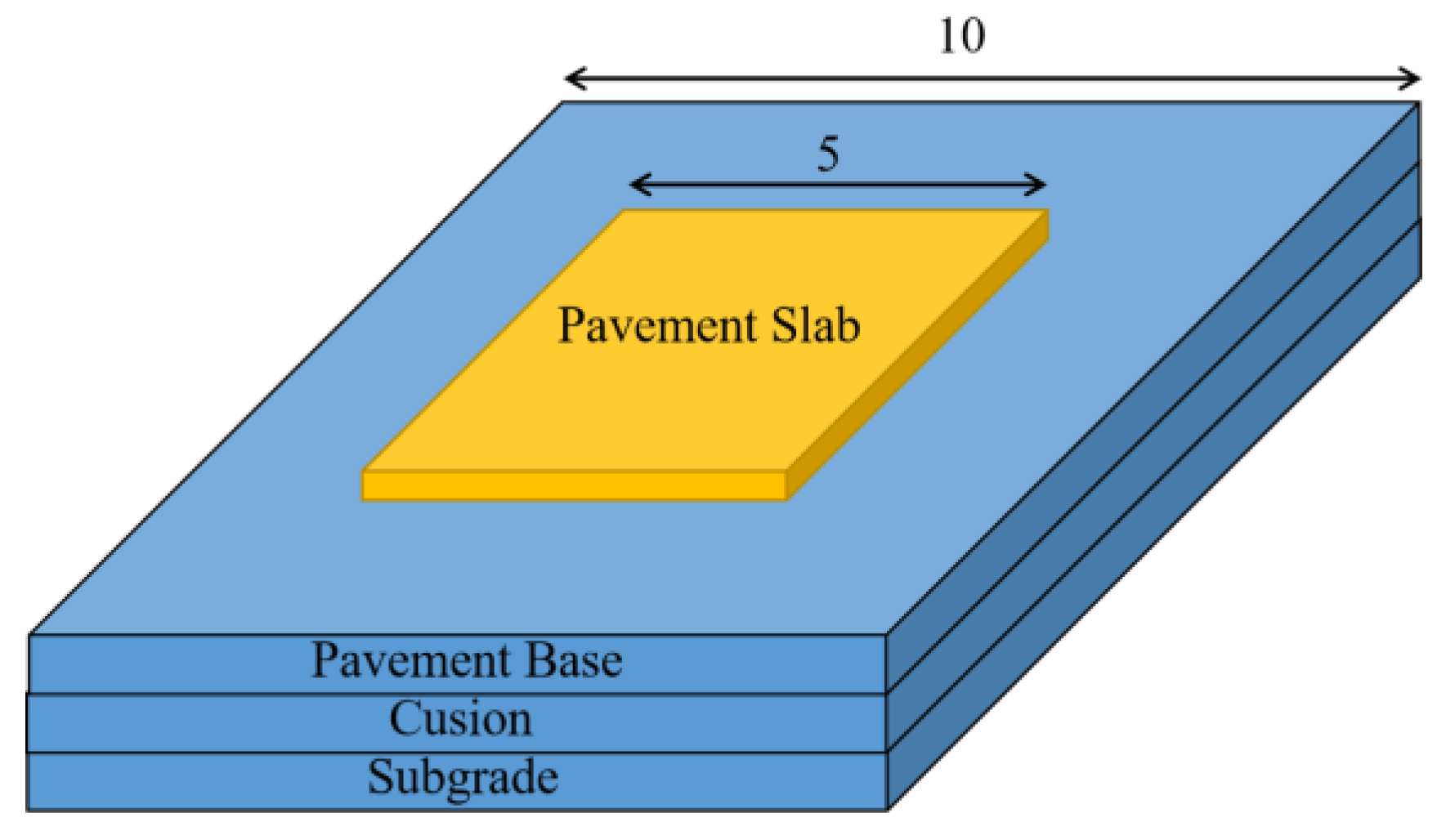
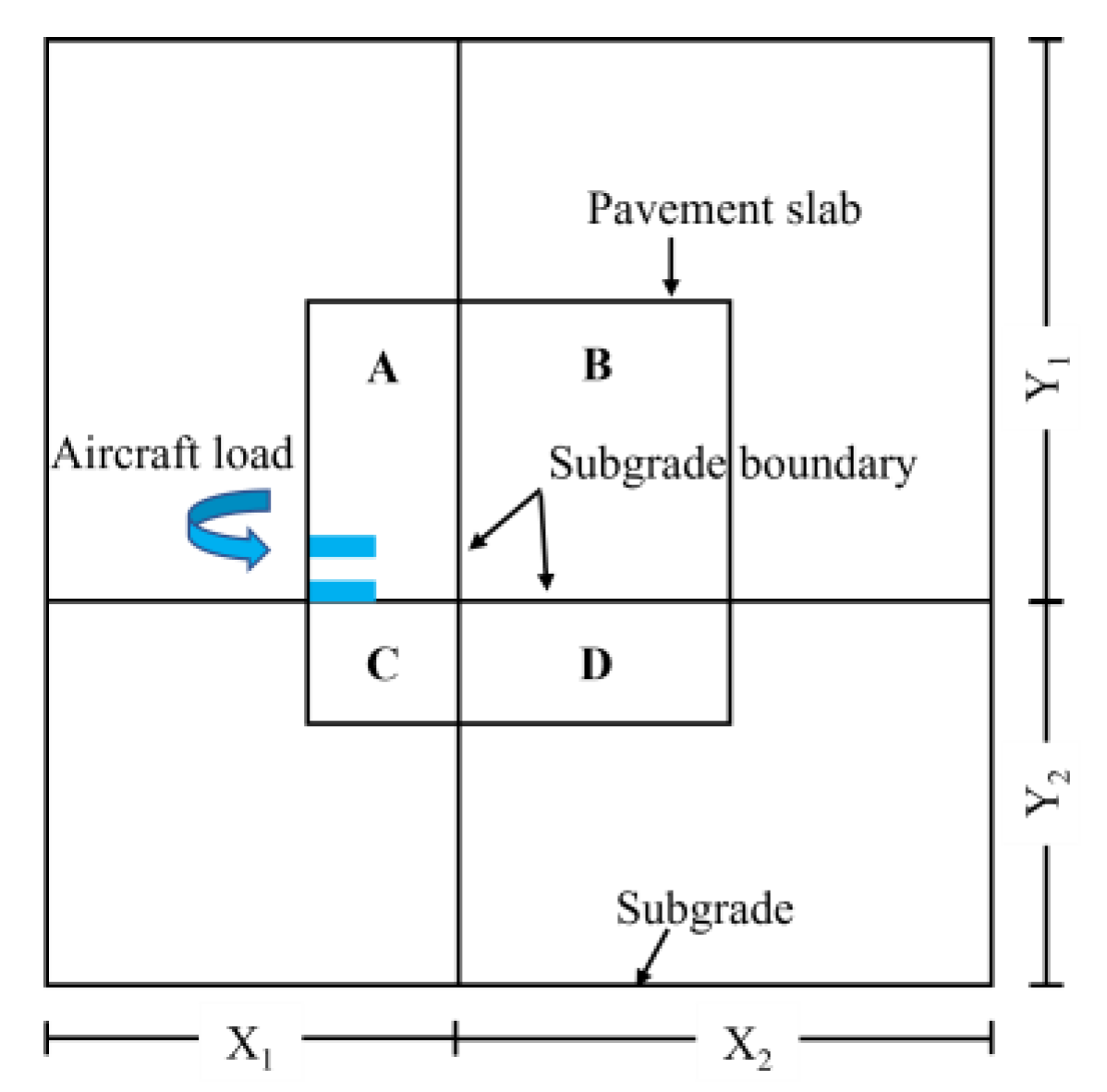





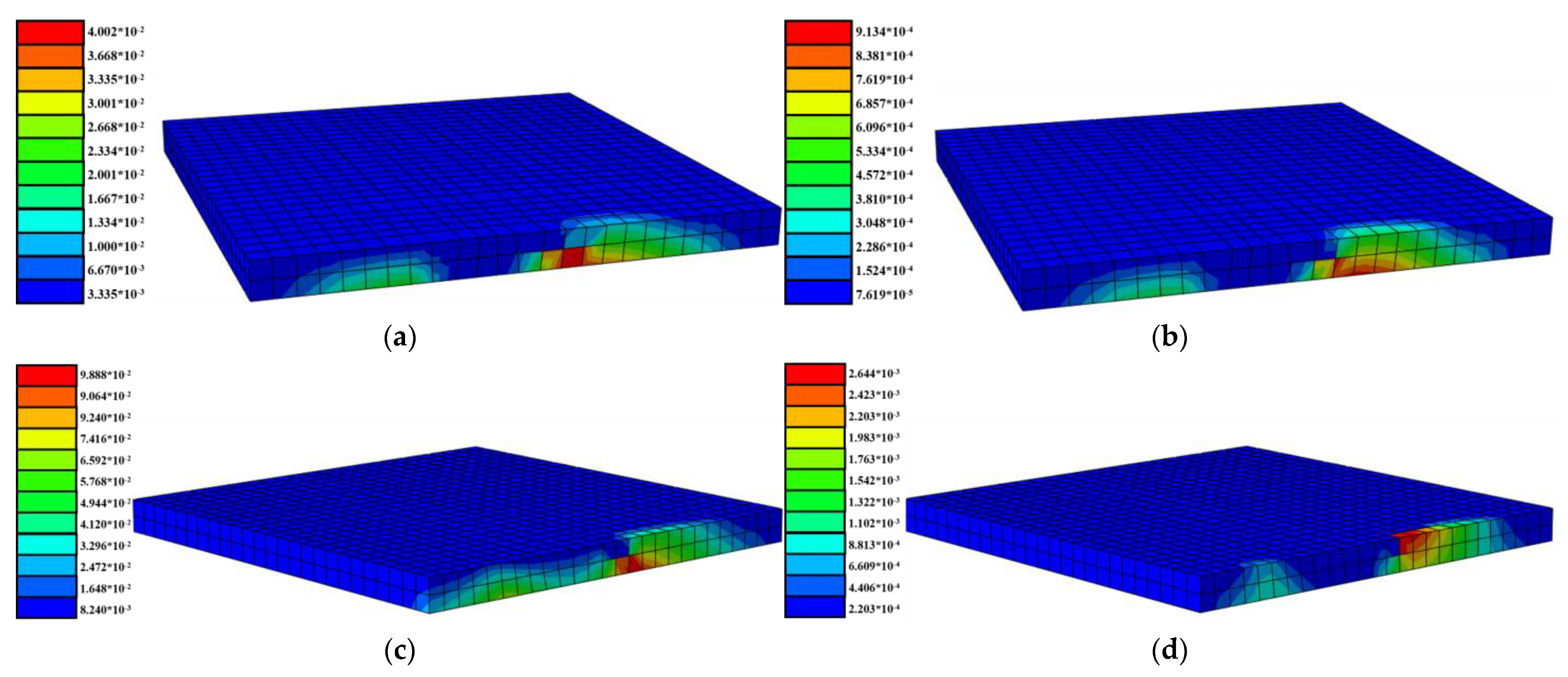
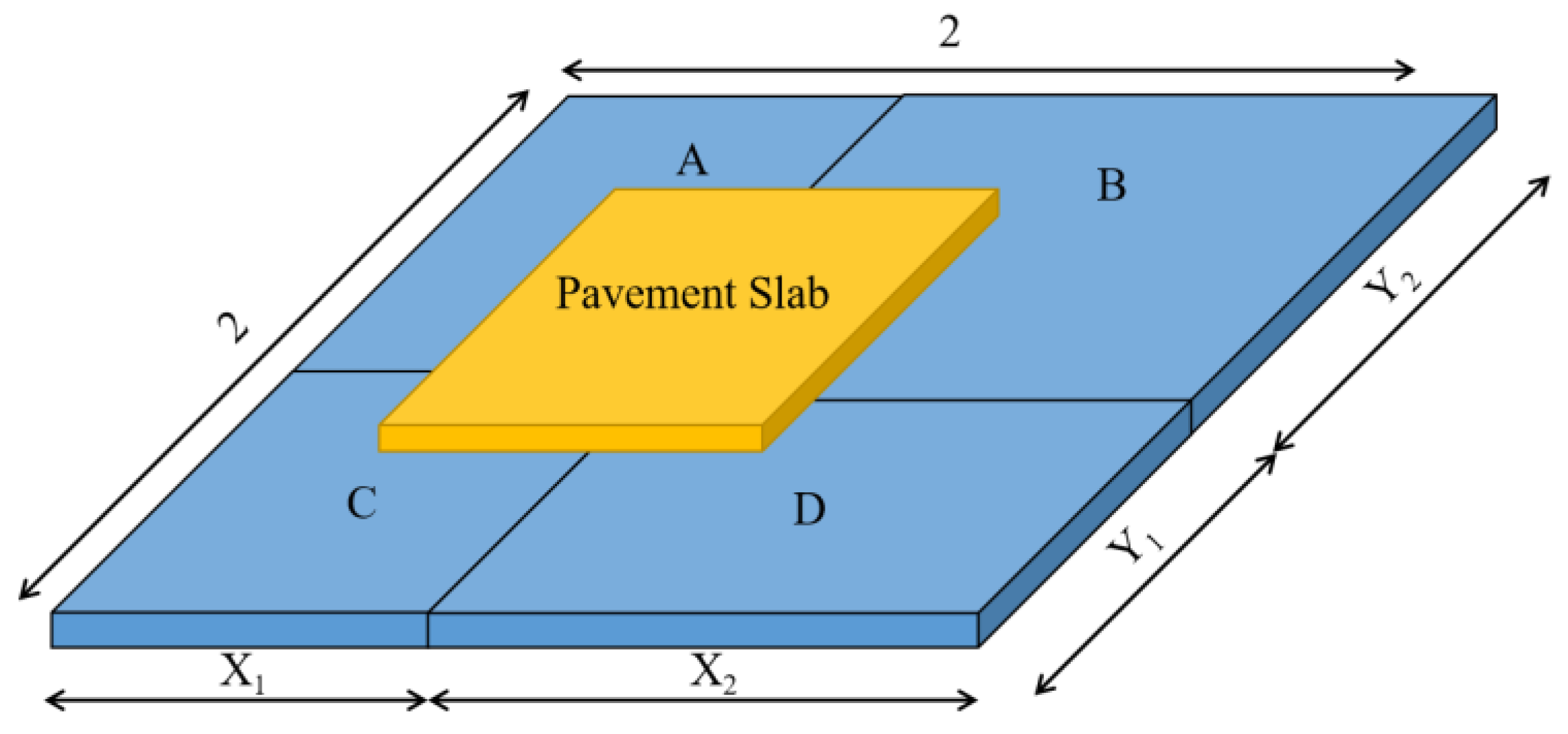
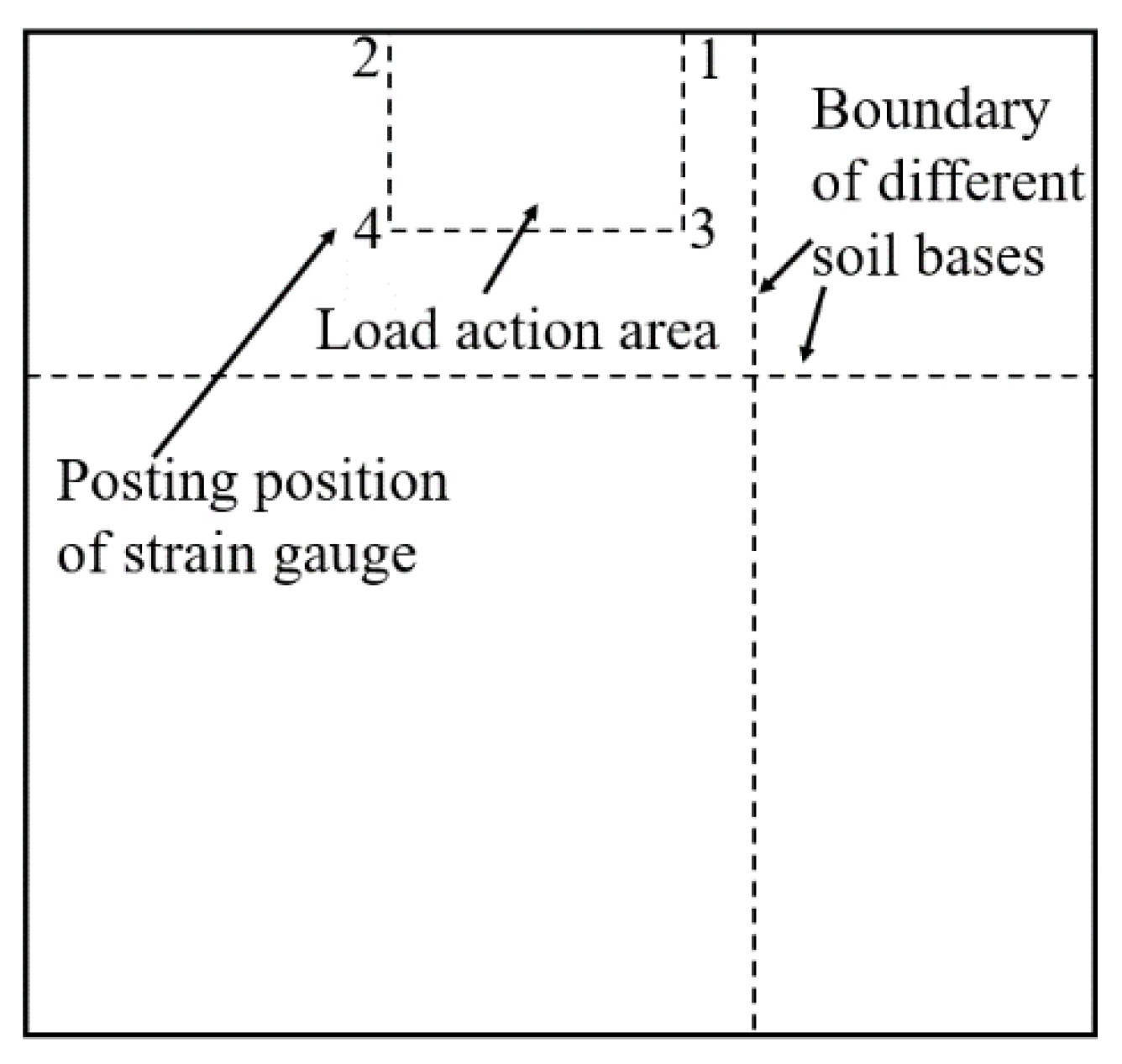

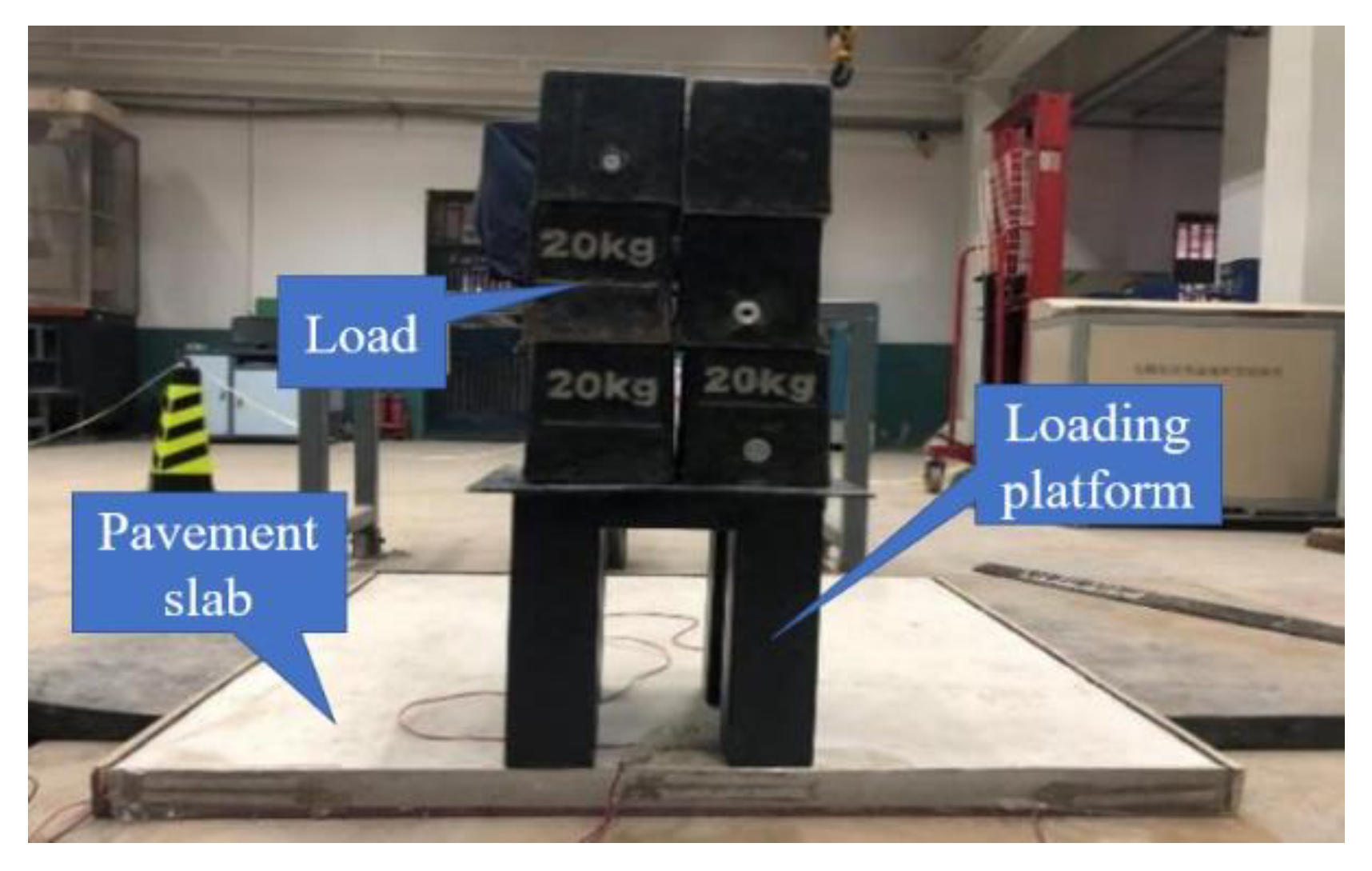

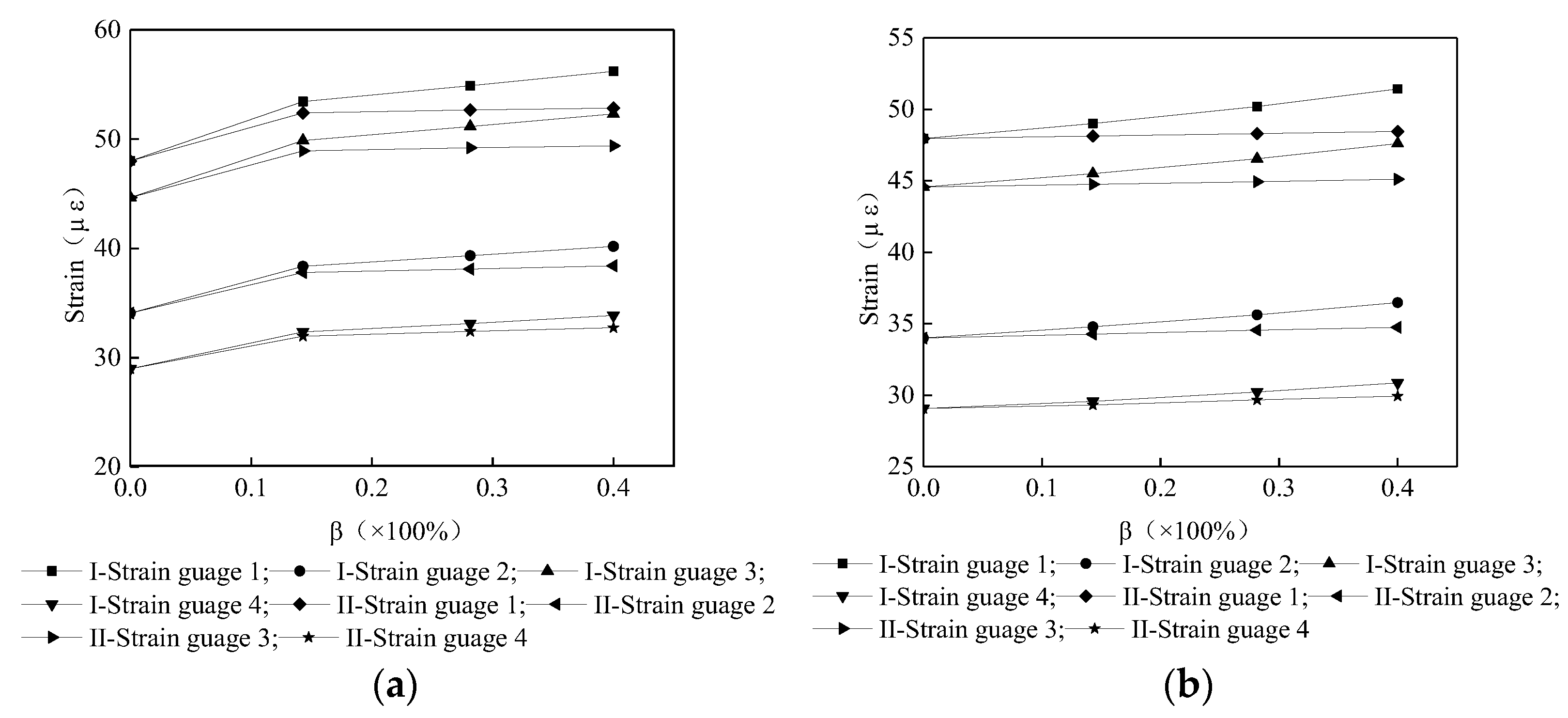


| Slab Thickness/m | Maximum Temperature Gradient/(°C/m) |
|---|---|
| 0.36 | 58.96 |
| 0.38 | 55.44 |
| 0.40 | 51.92 |
| Pavement Layer | Elasticity Modulus (MPa) | Poisson Ratio | Density (kg∙m−3) | Thickness (m) | Resilience Modulus (MPa) | Reaction Modulus (107 MPa) |
|---|---|---|---|---|---|---|
| cement concrete pavement layer | 36,000 | 0.15 | 2400 | 0.36, 0.38, 0.40 | / | / |
| cement stabilized macadam base | / | 0.25 | / | 0.2 | 1500 | / |
| natural sand cushion | / | 0.3 | / | 0.3 | 200 | |
| subgrade | / | / | / | / | / | 10, 20, 40, 60, 70 |
| Aircraft Model | B737-800 | A320 | |
|---|---|---|---|
| Weight (kN) | 792.60 | 774.00 | |
| Partition coefficient of landing gear | 0.95 | 0.95 | |
| Distance of landing gear (m) | 5.72 | 7.60 | |
| Number of landing gear wheel | 2 | 4 | |
| Number of landing gear | 2 | 2 | |
| Spacing of landing gear wheel (m) | St | 0.86 | 0.78 |
| SL1 | / | 1.01 | |
| SL2 | / | / | |
| Tire pressure (MPa) | 1.47 | 1.14 | |
| Aircraft Model | Tire Pressure (MPa) | Wheel Print Area (m2) | Wheel Print Length (m) |
|---|---|---|---|
| A320 | 1.14 | 0.16 | 0.4 |
| B737-800 | 1.47 | 0.13 | 0.36 |
| Condition | Y1:Y2 | X1:X2 | Reaction Modulus of Subgrade (MPa) | |
|---|---|---|---|---|
| 1 | I | 1:4 | 1:4 | A = D = 70, B = C = 10~70 |
| II | 1:4 | 1:4 | A = D = 10~70, B = C = 70 | |
| 2 | I | 2:3 | 2:3 | A = D = 70, B = C = 10~70 |
| II | 2:3 | 2:3 | A = D = 10~70, B = C = 70 | |
| 3 | I | 2:3 | 1:4 | A = D = 70, B = C = 10~70 |
| II | 2:3 | 1:4 | A = D = 10~70, B = C = 70 | |
| Condition of Test | Reaction Modulus of Subgrade | Distribution Range of Subgrade |
| 1 | I: A/D zone: 70.13 Mpa, B/C zone: 42.08 MPa | X1:X2 = 2:3, Y1:Y2 = 2:3; X1:X2 = 2:3 Y1:Y2 = 1:4; |
| II: A/D zone: 42.08 MPa, B/C zone: 70.13 MPa | ||
| 2 | I: A/D zone: 70.13 MPa, B/C zone: 50.29 MPa | |
| II: A/D zone: 50.29 MPa, B/C zone: 70.13 MPa | ||
| 3 | I: A/D zone: 70.13 MPa, B/C zone: 60.16 MPa | |
| II: A/D zone: 60.16 MPa, B/C zone: 70.13 MPa | ||
| 4 | A/B/C/D zone: 70.13 MPa | Uniform subgrade |
Disclaimer/Publisher’s Note: The statements, opinions and data contained in all publications are solely those of the individual author(s) and contributor(s) and not of MDPI and/or the editor(s). MDPI and/or the editor(s) disclaim responsibility for any injury to people or property resulting from any ideas, methods, instructions or products referred to in the content. |
© 2023 by the authors. Licensee MDPI, Basel, Switzerland. This article is an open access article distributed under the terms and conditions of the Creative Commons Attribution (CC BY) license (https://creativecommons.org/licenses/by/4.0/).
Share and Cite
Huang, X.; Sun, B.; Tan, C.; Li, Z.; Qi, L. Numerical Analysis and Experimental Study of the Mechanical Response of Pavement Slab Supported on an Inhomogeneous Settlement. Appl. Sci. 2023, 13, 9808. https://doi.org/10.3390/app13179808
Huang X, Sun B, Tan C, Li Z, Qi L. Numerical Analysis and Experimental Study of the Mechanical Response of Pavement Slab Supported on an Inhomogeneous Settlement. Applied Sciences. 2023; 13(17):9808. https://doi.org/10.3390/app13179808
Chicago/Turabian StyleHuang, Xin, Bowei Sun, Chengsong Tan, Zhengkai Li, and Lin Qi. 2023. "Numerical Analysis and Experimental Study of the Mechanical Response of Pavement Slab Supported on an Inhomogeneous Settlement" Applied Sciences 13, no. 17: 9808. https://doi.org/10.3390/app13179808
APA StyleHuang, X., Sun, B., Tan, C., Li, Z., & Qi, L. (2023). Numerical Analysis and Experimental Study of the Mechanical Response of Pavement Slab Supported on an Inhomogeneous Settlement. Applied Sciences, 13(17), 9808. https://doi.org/10.3390/app13179808




